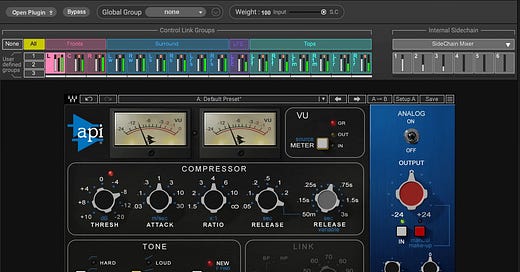When Waves recently released their Immersive Wrapper plugin, I approached it with skepticism. The $250 price tag for a tool that essentially transforms mono Waves plugins into multi-channel processors seemed excessive, particularly given my reservations about Waves’ business practices over the past couple of years. Yet after spending time with the Immersive Wrapper, I’ve found myself reconsidering its place in the immersive audio production landscape, particularly for its approach to one of our most persistent challenges: the relationship between objects and beds in Dolby Atmos.
The Object-Bed Relationship
The Immersive Wrapper’s most intriguing feature isn’t immediately obvious when you first launch the plugin. Hidden behind its clean interface is a sophisticated approach to group linking that addresses a fundamental challenge in object-based audio production.
When working with object-oriented formats like Dolby Atmos, we’re essentially navigating two parallel worlds: the foundational bed that creates our ambient soundscape and the discrete objects that dance throughout our three-dimensional space. What’s fascinating is how these elements need to interact cohesively while maintaining their distinct identities and functions.
In traditional stereo or even 5.1 surround productions, we’ve become accustomed to treating our audio as a unified entity. Every element lives within the same dimensional constraints. But immersive audio challenges this paradigm–suddenly we’re orchestrating elements that operate on completely different principles.
Most processing tools available to us today weren’t designed with this duality in mind. They were conceived for channel-based workflows, where each channel receives identical processing or, at best, offers basic linking options. This creates a significant disconnect when we try to maintain sonic coherence between beds and objects in Atmos productions.
The Group Linking Innovation
The Immersive Wrapper’s approach to this challenge reveals itself in its global grouping functionality. During my testing, I discovered how the plugin allows you to link multiple instances across different channel configurations—effectively creating a bridge between your bed and object processing.
Consider a situation where you’ve crafted the perfect compression settings for your 7.1.4 bed using the Immersive Wrapper with an SSL compressor. In conventional workflows, applying those same settings to objects would require either duplicating settings across multiple instances with tedious precision or accepting subtle inconsistencies in your mix. The Immersive Wrapper elegantly solves this by allowing stereo instances on object tracks to respond to specific speaker groups from your bed.
A particularly clever aspect of the Waves implementation is its consideration of how object placement affects their processing. Using the plugin’s group selectors, an object positioned primarily in the height plane can receive processing aligned with the height channels of your bed, while an object panning through the surround field can maintain sonic compatibility with surround bed channels.
This relational approach represents a significant paradigm shift in how we conceptualize audio processing. Rather than thinking in terms of individual channels or elements, the Immersive Wrapper encourages us to envision a cohesive three-dimensional space where processing is determined not just by content, but by spatial positioning. The four selector buttons in the stereo instance—enabling you to link object processing to fronts, surrounds, LFE, or heights—create an intuitive spatial relationship between otherwise disparate mix elements.
The Ecosystem Limitation
Despite its innovative approach to the object-bed relationship, the Immersive Wrapper is constrained by a significant limitation: it only works with other Waves plugins. This constraint highlights a broader challenge in the immersive audio domain–ecosystem lock-in.
Professional engineers often find themselves committed to specific toolsets and workflows that have served them well in stereo and surround production. The transition to immersive formats shouldn’t require abandoning these familiar tools, yet the reality is that immersive audio production often forces us into new ecosystems. The Immersive Wrapper exemplifies this tension—while offering an elegant solution to a complex problem, it simultaneously deepens dependence on the Waves ecosystem.
When evaluating this plugin, I weighed its capabilities against this ecosystem constraint. The ideal immersive audio tool would bridge ecosystems rather than create new walled gardens, allowing engineers to leverage their existing expertise and preferred processing chains while extending functionality into the immersive domain. Had the Immersive Wrapper worked with any VST plugin, its $250 price tag would feel more justified.
For hobbyists and smaller studios beginning their immersive audio journey, this ecosystem question becomes even more critical. The investment required for comprehensive immersive workflows can be substantial, making it essential that new tools offer value and flexibility proportionate to their cost. The Immersive Wrapper’s pricing structure—available only as a standalone purchase or through Waves’ Ultimate subscription tier—makes it a significant investment decision that extends beyond the plugin itself to a commitment to the broader Waves ecosystem.
A Specialized Tool for a Select Audience
The Waves Immersive Wrapper points toward an exciting future for immersive audio processing. Its approach to the bed-object relationship, particularly the intelligent linking between different channel configurations, represents a significant step forward in immersive mixing workflows. As this technology evolves, I expect we’ll see even more sophisticated approaches that build upon these concepts.
The capability to create custom groupings that respond intelligently to spatial positioning—as shown in the Immersive Wrapper’s user-defined groups—hints at more advanced possibilities ahead. Imagine processing that automatically adapts as objects move through different regions of your immersive space, maintaining consistent sonic character while respecting the spatial integrity of your mix. The Waves implementation offers a glimpse of this potential, even while remaining constrained by its ecosystem.
For now, the Immersive Wrapper presents a compelling option for specific user groups. If you already have the Waves Ultimate subscription, the plugin represents genuine added value for immersive production. Similarly, professionals deeply invested in the Waves ecosystem will find its workflow enhancements to justify the investment. However, hobbyists or those working across multiple plugin ecosystems might find better value in more flexible alternatives like Red Rock Sound’s immersive audio plugins, which offer similar functionality at a lower price point.
Watch the full video review of Wave’s Immersive Wrapper plugin here:




